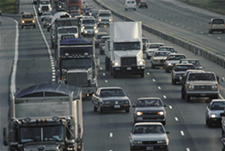
 |
||
Traffic BottlenecksFHWA Programs Address Bottlenecks from Varied PerspectivesPublicationsRecurring Traffic Bottlenecks: A Primer Focus on Low-Cost Operational Improvements (Fourth Edition)An Agency Guide on How to Establish Localized Congestion Mitigation ProgramsAn Agency Guide on Overcoming Unique Challenges to Localized Congestion Reduction ProjectsTraffic Analysis Toolbox Volume X: Localized Bottleneck Congestion Analysis Focusing on What Analysis Tools Are Available, Necessary and Productive for Localized Congestion RemediationComplimentary copies may be ordered by sending an email to Neil.Spiller@dot.gov. Bottleneck Projects provide Bang for the Buck!"This project has almost entirely eliminated the constant traffic back-ups at the merge point. Thank you very much!" - A Citizen See what project he was talking about. "Thus, a perennial member (4th worst in 2008) of the nation's top 10 worst segments was dramatically improved (now 491st in 2009) with some new paint." Working through the federal aid apportionment and MAP 21 processes, the Federal Highway Administration (FHWA) and our State partners are engaged in many programs related to congestion impact. Here are just a few links to some of the many congestion mitigation efforts that FHWA is engaged in: Congestion Pricing, high-occupancy vehicle legislation and enablement, Urban Partnerships, freight-specific analysis, special events, work zone congestion mitigation, traffic incident delay mitigation, and other driver behavior solutions, like ridesharing incentives, car sharing, and telecommuting. Within the Office of Operations, the Localized Bottleneck Reduction (LBR) Program serves to bring attention to the root causes, impacts, and potential solutions to traffic chokepoints that are recurring events; ones that are wholly the result of operational influences. That program is the focus of the remainder of the web site.  Localized Bottleneck Reduction ProgramThe LBR program is targeted at point-specific locations (e.g., ramps, lane squeezes, weave areas, abrupt changes in highway alignments, etc) or small corridors of delay, as opposed to larger "mega-projects" or systemic congestion. Systemic congestion is often analogous to entire corridors or regional congestion; a situation that is far and above the focus of this program area. Bottlenecks are either recurring (predictable, static) or nonrecurring (random, dynamic) in cause. The LBR Program focuses on recurring bottlenecks; i.e., those that are operationally influenced by design or function, and impacted upon by traffic over-demand. All things being equal, a recurring bottleneck will disappear once the traffic volume has decreased to where the operationally influenced deficiency no longer comes into play. A nonrecurring bottleneck will disappear once the random event is removed. A nonrecurring event may be further impacted by volume, but it is not volume-based. Only a physical improvement will relieve a recurring bottleneck. Acknowledging that even mega-bottlenecks are realistically correctable given a "blank check", unlimited right of way, and non-competing priorities, operational bottlenecks are merely a smaller sub-category of all bottlenecks. What are "operational influences?" A bottleneck is "congestion" but congestion is often more than a bottleneck. What is the LBR Program definition of a "Bottleneck"? What about "Freight Bottlenecks?" Isn't that a unique FHWA program area? What elements typically exist to define a "Bottleneck"? What options exist to combat congestion (and by extension, bottlenecks)? What are "Active Traffic Managed" solutions? Does "Poor Planning" cause congestion? Don't Interchange the Terms 'Demand' and 'Congestion' How can bottlenecks be identified and assessed? What is stopping us from fixing bottlenecks? Are We Blurring the Lines Between Recurring and Nonrecurring Causes? Summary of 2008 Workshop SeriesThree LBR workshops were held in 2008 to bring together state and local transportation agency representatives to discuss programs to reduce bottlenecks. Read More… Good Ideas!A Sampling of Successful Bottleneck Projects Nationwide A Sampling of how State DOTs Incorporate Bottleneck Attention in their Processes One-page Case Studies you can Print off as Handouts Contact InformationNeil Spiller E-mail: Neil.Spiller@dot.gov You may need the Adobe® Reader® to view the PDFs on this page. |
||
| US DOT Home | FHWA Home | Operations Home | Privacy Policy | ||